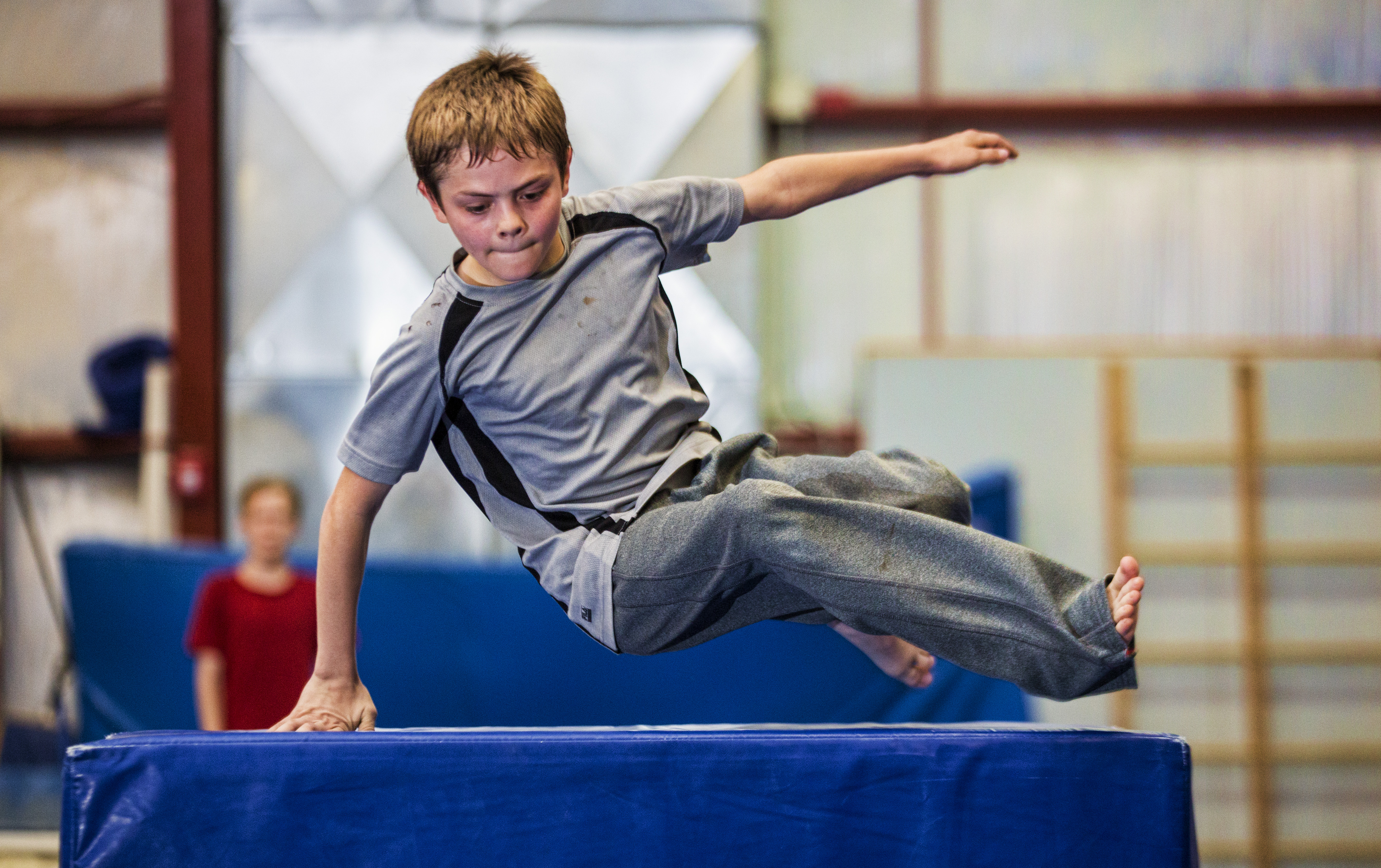Once just an underground movement, parkour gets a class of its own in Lawrence

Eleven-year-old Christian Bandel uses one arm to spring over a vault during a parkour class held at Lawrence Gymnastics Academy, 4930 Legends Dr. on Sunday, May 17, 2015.
Across the globe, the gap-jumping, wall-scaling, obstacle-vaulting training discipline known as parkour has only recently begun to outgrow its underground popularity. And it’s even entering the mainstream right here in Lawrence.
Once an unorganized activity reserved for the back alleys of urban areas, training programs, gyms and competitions are now sprouting around parkour.
In Lawrence, under the name Trace. Arts and Development., Jason Boyer and Sam Sivagnanam occupy the entire Lawrence Gymnastics Academy facility two days a week to cultivate a new generation of “traceurs” — the name for parkour enthusiasts.

Eleven-year-old Christian Bandel uses one arm to spring over a vault during a parkour class held at Lawrence Gymnastics Academy, 4930 Legends Dr. on Sunday, May 17, 2015.

Fourteen-year-old William Gallagher leaps high in the air off a balance beam during a parkour class held at Lawrence Gymnastics Academy, 4930 Legends Dr. on Sunday, May 17, 2015.

Jason Boyer demonstrates a technique for leaping over vaults during a parkour class held at Lawrence Gymnastics Academy, 4930 Legends Dr. on Sunday, May 17, 2015.
How to enroll
Trace Arts and Development returns for another round of classes June 14. For more information, visit TraceAD.org or email tracead.mail@gmail.com.
Parkour is frequently described as a method of running from point A to point B (obstacles are usually in the way) in the quickest, most efficient way possible. According to the World Freerunning Parkour Federation, it originated in France (“parcours” is French for “course”) in the 1980s and its development was influenced by martial arts, gymnastics and military training — despite its being nonviolent and championing safety.
“Rather than a discipline for learning how to fight like martial arts, it’s a discipline for flight,” Boyer said. “People assume there’s this dangerous, X-games, skateboard vibe to it because the videos are all based on flipping off buildings, and that’s really just a very small portion of the world and something that very few people are even skilled enough to try.”
Outside of parkour, Boyer and Sivagnanam live in Kansas City, where they run a bakery called GF+1, while Sivagnanam also works as a research assistant for a medical research facility.
Both became traceurs in the late 2000s after documentaries like “Jump London” and waves of YouTube videos uncovered the underground movement.
The two began offering classes in 2010 when Lawrence was their home. Boyer had spent some time volunteering for a Boys and Girls Club program at Schwegler School, where games of tag got him thinking he could teach them parkour.
In the five years since, they’ve relied almost entirely on word-of-mouth and social media to grow the program. On a Sunday night in May, nine students showed up for another lesson at the Lawrence Gymnastics Academy, which comes heavily padded and full of bars, balance beams and other fun things to fly over or under.
The students ranged in age from 8 to 17. One girl was present. They came in different sizes too — some tall and lean, others more on the stocky side.
Yet they all performed the same exercises. They ran up — and spun off — walls. At full speed they vaulted headfirst over thick, padded mats and (some) landed on their feet. They swung from a tall bar to a lower one and threaded their bodies through a narrow window between the bar and an elevated mat underneath them.
They’re taught such efficiencies as to not “float” whenever airborne. If they have to plant their feet when swinging over an obstacle, they should use the motion as a chance to kick themselves forward and off it.
They also learn how to crash, too.
“Roll! Don’t fall on your face,” Sivagnanam said after one student caught his foot on an obstacle, ruining his mid-air momentum, and he decided not to do much about it as he hit the padded ground.
Three of the students said after the class that they didn’t have any gymnastic-like background before enrolling. They first heard of parkour through YouTube videos.
“It’s really fun,” said Joseph Schmidtberger, 14, who’s been in the class for six months and practices on his own time. “It’s hard to explain it to (other people). They’re like, ‘So pretty much you’re just jumping over things. Wow.’ “
Boyer and Sivagnanam said the parents involved often struggle at first to get a grasp on what their kids are doing. The gymnastics academy has a loft with a vending machine and seating area. During the beginning of a new “semester,” the area will be filled with parents. On this Sunday in May, the penultimate class of the semester, two parents are hanging around.
One of them, Heather McPeek, of Eudora, said she sometimes worries about her 13-year-old son Owen hurting himself, “but he’s pretty good.”
“We feel like we must be doing a good job because the parents stop coming at a certain point,” Boyer said. “They trust what we’re doing.”
Boyer and Sivagnanam said the class is about teaching the basics and students aren’t expected to reach a particular level of skill by semester’s end. Parkour is all about self-improvement, they said.
“We’ve seen incredible progress from kids that couldn’t even stand on one foot on the ground, who can now run on a balance beam and dive off of it and roll,” Sivagnanam says. “You can start really un-athletic and do things that you never really knew you can do.”







